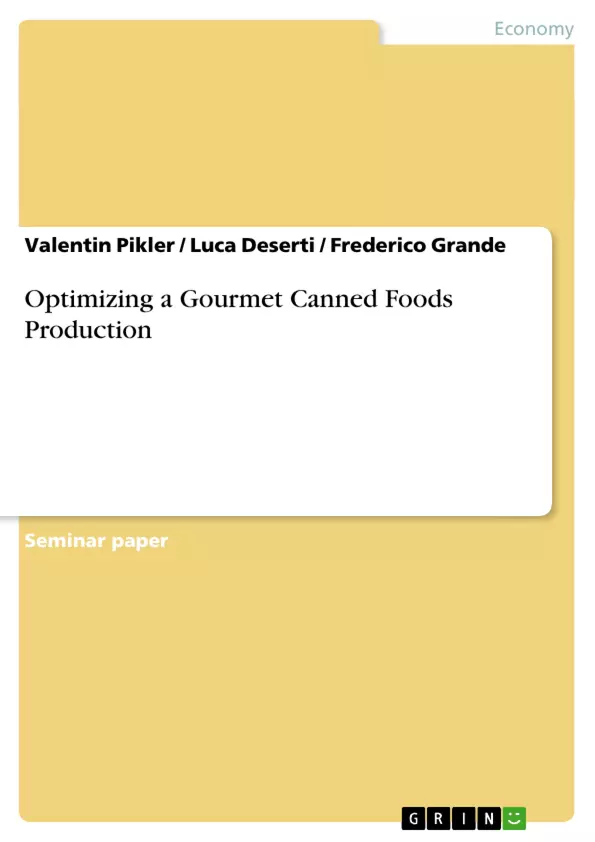In mathematics, linear programming (LP) problems are optimization problems in which the objective function and the constraints are all linear. Linear programming is an important field of optimization for several reasons. Many practical problems in operations research can be expressed as linear programming problems. Certain special cases of linear programming, such as network flow problems and multicommodity flow problems are considered important enough to have generated much research on specialized algorithms for their solution. A number of algorithms for other types of optimization problems work by solving LP problems as sub-problems. Historically, ideas from linear programming have inspired many of the central concepts of optimization theory, such as duality, decomposition, and the importance of convexity and its generalizations. (wikipedia.com) Linear programming (LP) is one of the most widely applied O.R. techniques and owes its popularity principally to George Danzig's simplex method (Danzig 1963) and the revolution in computing. It is a very powerful technique for solving allocation problems and has become a standard tool for many businesses and organisations. Although Danzig's simplex method allows solutions to be generated by hand, the iterative nature of producing solutions is so tedious that had the computer never been invented then linear programming would have remained an interesting academic idea, relegated to the mathematics classroom. Fortunately, computers were invented and as they have become so powerful for so little cost, linear programming has become possibly one of the most widespread uses for a personal PC. (wikipedia.de) There are of course numerous software packages which are dedicated to solving linear programs (and other types of mathematical program), of which possibly LINDO, GAMS and XPRESS-MP are the most popular. All these packages tend to be DOS based and are intended for a specialist market which requires tools dedicated to solving LPs. In recent years, however, several standard business packages, such as spreadsheets, have started to include an LP solving option, and Microsoft Excel is no exception.
Inhaltsverzeichnis (Table of Contents)
- Introduction
- Standard form
- The problem
- Solution of the Problem
- Primal
- Answer Report
- Sensitivity Report
- Limits Report
- Dual
- Answer Report
- Sensitivity Report
- Limits Report
- Primal Dual theorem
- Primal
- Dual
- Economic Interpretation
- References
Zielsetzung und Themenschwerpunkte (Objectives and Key Themes)
This document aims to demonstrate the application of linear programming (LP) in optimizing the production of gourmet canned foods. It uses a real-world example of a small canning company to illustrate how LP can be used to maximize profit while considering constraints such as production capacity, material availability, and market demand.
- Linear programming as a tool for optimizing production processes
- Formulating and solving linear programming problems
- Analyzing sensitivity and limits reports for decision-making
- Economic interpretation of dual variables
- The application of LP in a real-world business scenario
Zusammenfassung der Kapitel (Chapter Summaries)
- Introduction: This chapter defines linear programming and outlines its significance in operations research. It provides a brief overview of the application of linear programming in business.
- Standard form: This chapter defines the standard form of a linear programming problem, outlining the objective function and constraints in a typical LP model. It explains the components of the model, including the objective function and the constraints.
- The problem: This chapter presents a real-world scenario of a small canning company that produces gourmet canned foods. The company has constraints related to production capacity, material availability, and market demand. This chapter lays out the problem and the key variables involved.
- Solution of the Problem: This chapter delves into the solution of the linear programming problem presented in the previous chapter. It outlines the steps taken to solve the problem, including the primal and dual solutions, and provides detailed information about the various reports generated by the LP solver.
- Primal Dual theorem: This chapter explores the relationship between the primal and dual solutions of a linear programming problem. It explains the economic interpretation of the dual variables and how they relate to the decision-making process.
Schlüsselwörter (Keywords)
The key concepts explored in this document include linear programming, optimization, production planning, constraints, objective function, primal solution, dual solution, sensitivity analysis, limits report, economic interpretation, and real-world application.
- Citation du texte
- Valentin Pikler (Auteur), Luca Deserti (Auteur), Frederico Grande (Auteur), 2006, Optimizing a Gourmet Canned Foods Production, Munich, GRIN Verlag, https://www.grin.com/document/53360



